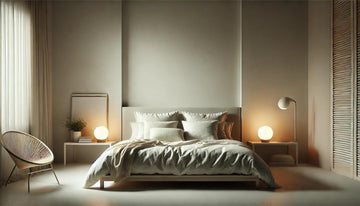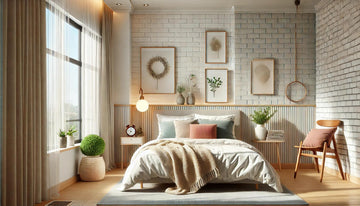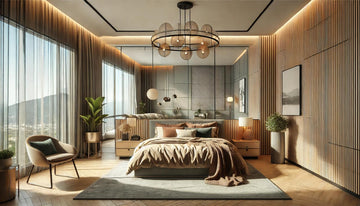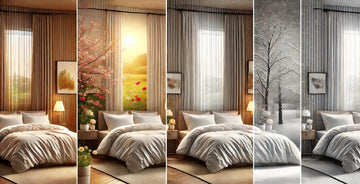Your bedroom is more than just a place to sleep; it's your personal sanctuary, a haven to unwind after a long day. Achieving the perfect relaxing ambiance in your bedroom can make a world of difference in your sleep quality and overall well-being. The key to transforming your bedroom into a serene retreat lies in creating the right lighting setup. In this guide, we’ll explore the best ways to use lighting to craft a calming atmosphere that allows you to rest, recharge, and rejuvenate.
1. Understanding the Power of Layered Lighting

When it comes to bedroom lighting, it's essential to use a combination of different types of lighting rather than relying on a single light source. This technique, known as layered lighting, involves using ambient, task, and accent lighting to create a balanced, cozy space. Here’s a breakdown of the three layers:
-
Ambient Lighting: This is the main source of light in your room, usually provided by overhead lights or ceiling fixtures. Opt for dimmable lights so you can adjust the brightness depending on your mood. Soft, diffused ambient lighting works best for a relaxed atmosphere, preventing harsh shadows and creating a soothing glow throughout the space.
-
Task Lighting: Task lighting serves a functional purpose, such as bedside lamps for reading or a desk lamp for late-night work. Choose lamps that offer focused light without being overly bright. For a relaxing bedroom, it's best to avoid high-intensity task lights and instead select fixtures with warm-toned bulbs.
-
Accent Lighting: Accent lighting adds depth and character to your bedroom. It could include wall sconces, LED strip lights behind headboards, or small spotlights to highlight artwork. Accent lighting is perfect for adding a touch of elegance and warmth, contributing to the overall relaxing vibe.
2. Choosing the Right Color Temperature

Color temperature is a crucial factor in setting the right mood in your bedroom. Light color temperature is measured in Kelvin (K), and different temperatures have varying effects on our emotions and relaxation levels.
-
Warm White (2,700K - 3,000K): This is the ideal color temperature for a relaxing bedroom. Warm white light mimics the soft, golden glow of the sunset, signaling your body that it's time to wind down. It creates a cozy, inviting atmosphere that promotes relaxation.
-
Avoid Cool White Light: Lights with higher color temperatures (above 4,000K) emit a bright, bluish light, similar to daylight. While this is great for productivity, it can make it difficult to relax and signal to your body that it’s time for sleep. Stick to warmer tones for a comforting ambiance.
3. Incorporating Dimmable Lights

Dimmable lights are a game-changer for creating the perfect bedroom ambiance. They allow you to adjust the brightness to suit your needs—brighter during your evening routine and dimmer when you're ready to relax. Consider installing a dimmer switch for your overhead lights and using dimmable lamps for your bedside. This flexibility ensures you always have the right level of light for any situation, making it easier to transition from day to night.
4. The Magic of String Lights and Fairy Lights

Adding string lights or fairy lights is one of the easiest ways to infuse a cozy, whimsical feel into your bedroom. These lights are perfect for creating a soft glow that feels almost magical. Drape them along your headboard, around your window frames, or across a shelf to introduce a gentle, comforting light source. The twinkle and subtle glow from these lights can help you feel calm and relaxed, setting the perfect tone for a restful night.
5. Candles for a Soothing Glow

Nothing sets a relaxing mood quite like candles. Their soft, flickering glow adds warmth and serenity that’s difficult to replicate with electric lighting. You can opt for traditional wax candles or, for safety, battery-operated LED candles that mimic the effect of real flames. Scented candles can enhance relaxation even further—lavender, chamomile, or vanilla are popular options known for their calming properties.
6. Smart Lighting for Ultimate Control

Smart lighting systems can take your bedroom ambiance to the next level by giving you full control over your lights through your smartphone or voice assistant. You can change the color, adjust brightness, or set schedules to ensure the lights gradually dim as bedtime approaches. Smart bulbs allow you to create personalized lighting scenes that cater to your mood, making it effortless to wind down after a busy day.
7. Lampshades and Light Diffusion

The type of lampshade you choose can have a significant impact on the quality of light in your bedroom. Lampshades help diffuse light, preventing it from being too harsh or direct. Choose fabric or frosted glass lampshades to soften the light and create a gentler glow. Lamps with warm-toned shades are perfect for crafting a relaxing atmosphere, as they reduce glare and add a layer of warmth to the room.
8. Don’t Forget Natural Light

During the day, natural light plays a huge role in maintaining a relaxing bedroom atmosphere. Use lightweight curtains or blinds that let in natural light while preserving privacy. In the evenings, gradually dimming the lights can help signal to your body that it’s time to prepare for rest, complementing the natural circadian rhythm.
9. Avoid Harsh Overhead Lighting

Harsh overhead lights can create an unwelcoming environment, making it hard to relax. Instead of relying solely on a bright ceiling light, spread multiple smaller light sources around the room. This will help eliminate dark corners while avoiding the stark effect that a single, bright overhead light can have. A chandelier with dimmable bulbs or a ceiling fixture with a warm-toned diffuser can be an elegant choice that still maintains a calming atmosphere.
10. Create Zones with Lighting

To enhance relaxation, create different zones in your bedroom using lighting. For instance, use a soft floor lamp near a reading chair, install bedside lamps for night-time activities, and add accent lighting around artwork or plants. This approach allows you to emphasize different areas and activities in your room, encouraging you to transition smoothly from one to the next without disrupting your relaxation.
Conclusion
Creating a relaxing bedroom ambiance with lighting is all about layering light sources, choosing the right color temperatures, and adding elements that bring warmth and comfort. By incorporating these lighting strategies, you can transform your bedroom into a peaceful retreat that encourages rest and rejuvenation. With thoughtful lighting choices, your bedroom can become the perfect sanctuary where you can leave the stresses of the day behind and embrace tranquility.




